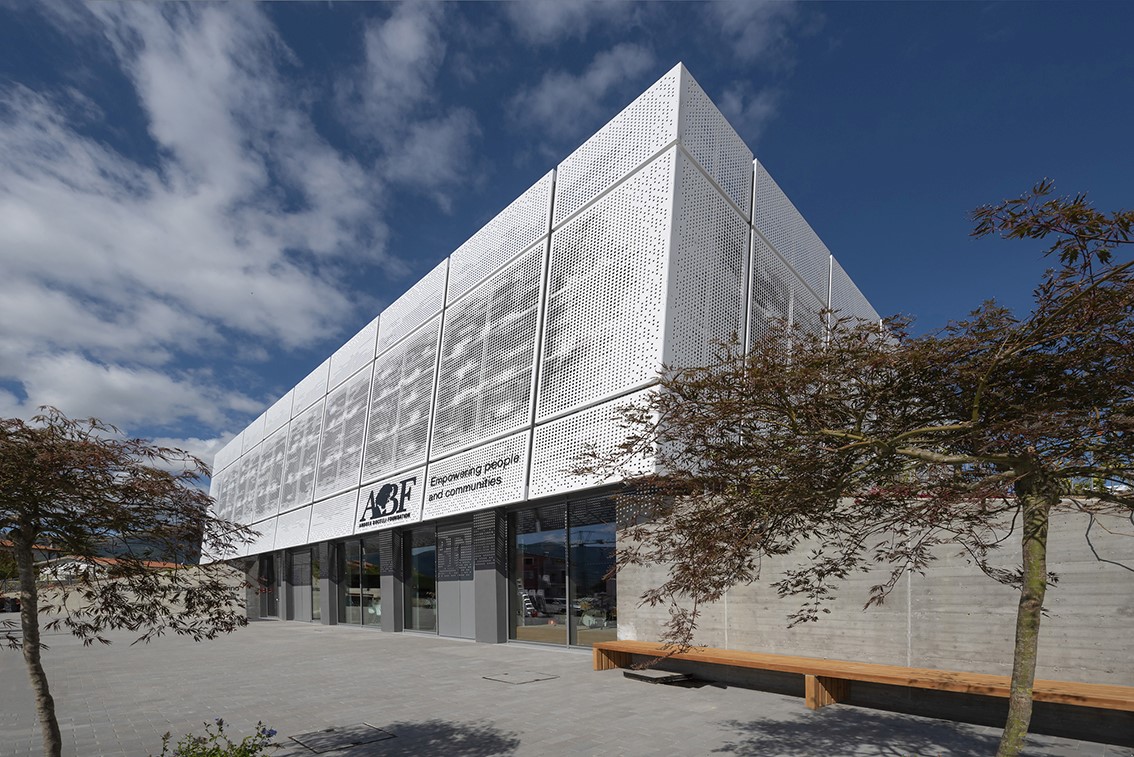
The recently reconstructed Academy of Music, delivered in Camerino, Italy, completes the project initiated by the young Harcome studio, Alvisi Kirimoto and the Andrea Bocelli Foundation. Carried out in compliance with the scheduled timing of only 150 working days, the reconstruction ranks as the third post-2016 earthquake intervention in central Italy, one of the most affected by earthquake events.
The project not only returns the local Academy of Music to Camerino, aimed at welcoming over 160 students and the many cultural initiatives of the community, but also gives the university city a new architectural identity. With clean and elegant lines, the building, which is spread over two levels for a total of 700 square meters, stands out for its ethereal skin in white sheet metal panels with perforations of varying size.
The north façade, visible from the street and from the upper garden, presents the volume as a box, with the panels suspended a few tens of centimeters from the ground. The two side elevations show the inclination and slope of the land. To the south, the skin that envelops the volume is interrupted, revealing the glazed ground floor behind which the auditorium, overlooking the historic center of Camerino, is hidden. A shady garden and the lower square constitute new open spaces available to the whole community.
Inside, the building houses an auditorium of 226 square meters in its basement, while the upper floor hosts an office and nine classrooms, two of which are larger than 30 square meters, one – destined for music for children from 0 to 6 years – is 22 square meters, and the remaining classrooms are around 14 square meters.
The interior design of the auditorium, aimed at enhancing the space despite its modest size, is characterized by the dynamic use of materials. The oak wood of the multiple surfaces and elements that make up the room, such as the suspended panels with different inclinations, circular strips, panels that emerge from the side wall and a backdrop covered with wood and the central stage with its rotating panels. In addition, concrete defines the main surfaces that forge the structure. The 180-seat stalls spread over three sectors, while in the lateral area, the artists’ path is inserted between the wooden wall panels and the full-height strips, which, like the pipes of an organ, bring rhythm to the space, alternating between full and empty.
The back wall, entirely transparent, connects the auditorium directly with the foyer, expanding the perception of space. In the foyer, rectangular wooden slats stand out from the back wall to the false ceiling, which slopes toward the entrance façade.
To connect the building vertically, in addition to the elevator, an orange resin staircase brings great liveliness and energy to the environment. In the classrooms, in addition to the necessary furnishings and musical instruments, mirrors and wooden panels invite students to personalize them with scores or musical compositions.
Open year-round and ready to host conferences, events, study activities and workshops at the service of the community, the new architecture presents itself as an educational and innovative forge dedicated to music, capable of giving Camerino a role of reference in the cultural panorama of the Marche region and beyond.
Project team
Client: Andrea Bocelli Foundation
Construction Manager and Coordinator: Eng. Paolo Bianchi
Construction site safety and management: PSC S.p.a. – Giovanni Perciante
Architecture: Alvisi Kirimoto with Andrea Gianfelici/Harcome






 Join our thriving community of 70,000+ superintendents and trade professionals on LinkedIn!
Join our thriving community of 70,000+ superintendents and trade professionals on LinkedIn! Search our job board for your next opportunity, or post an opening within your company.
Search our job board for your next opportunity, or post an opening within your company. Subscribe to our monthly
Construction Superintendent eNewsletter and stay current.
Subscribe to our monthly
Construction Superintendent eNewsletter and stay current.